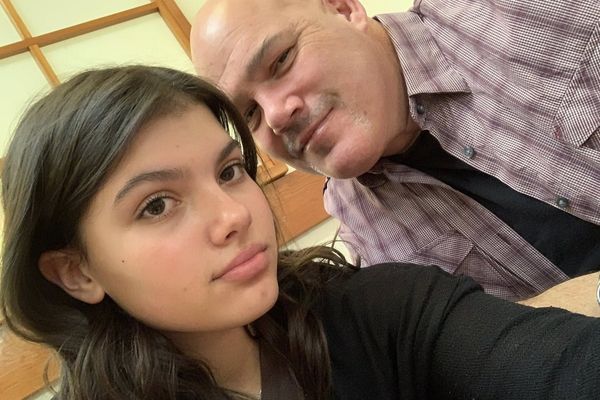
If you think of the canonical paintings of children in western art, their subjects are overwhelmingly white, cherubic baby Jesuses or aristocratic offspring overdressed in finery to reflect their parents’ status. Which is one reason why British artist Matthew Krishanu’s sparse, dreamlike paintings of young brown boys roaming free and having adventures in subtropical climes – loosely based on himself and his brother as children – feel so fresh and compelling. “The motivation even to represent these figures,” Krishanu says in his London studio, “and have them on the walls of galleries around the world, is a response to the historical disempowerment of the brown figure, and of children, within western art.”
Childhood and the histories of empire are central themes for the artist, who was born in Bradford to an Indian mother and white British father and lived from the ages of one to 12 in Dhaka, Bangladesh, where his parents worked as missionaries. These experiences have been distilled into ethereal vistas of the brothers boating, exploring landscapes of rushing water and purple mountains, as well as interior scenes of missionary activity in Dhaka.
His forthcoming exhibition Playground, at Niru Ratnam gallery in London, extends the theme of childhood within an urban environment. Paintings of children on a climbing frame, balancing on a wall or standing on a veranda line his studio walls, beckoning the viewer into their out-of-time universe like alluring memories one can’t quite place.

At the show’s core is the titular canvas Playground, from 2020, depicting a brown and a white child on a seesaw, supervised by a standing woman in a sari on one side and a white man on the other. It might be a portrait of childhood innocence, yet the positioning of the white child in the ascendant over the brown one is disquieting, evoking the violent history of imperial powers using Asia as their play arena.
These undercurrents are subtle yet implicit: Krishanu steers clear of didacticism, more interested in conjuring lived experiences and sensations in his atmospheric work. Figures are fluidly captured, with economy of detail. “I want the faces to be open enough to be many different people’s children, as opposed to the absolute particular,” he says. Specificities of location and time have been pared back, imbuing the paintings with what he calls “presentness”.
Krishanu builds his worlds from multiple sources. “For me,” he explains, “it’s about constructing something somewhere between imagination, art history, and then potentially a source material, like a photo.” One wall of his studio is taped with printouts of images from his extensive archive, testament to his continuing dialogue with art history. They currently include an Egyptian Fayum mummy portrait, a fragment from the Ajanta cave paintings in India, Gainsborough’s The Blue Boy, Rembrandt’s The Polish Rider and an El Greco Christ on the cross.

The artist points to two paintings of four boys and four girls by Edvard Munch that fed into his recent work Four Children (Verandah, 2022), but he has complicated the group’s dynamic by reconfiguring it as two European girls and two brown boys. In all his canvases, the children are treated with gravity, not sentimentalised. “There’s a certain kind of authenticity to their play that I want to portray,” he says. “The children have an interior life and a power.” In Boy on a Climbing Frame, the subject stands tall, anchored only by the curving frame, wearing a self-possessed, earnest expression as he looks down at the viewer.
In contrast, the adults exude a certain awkwardness, especially the white foreigners, such as the man in Playground sporting a green lungi. “In a way,” says Krishanu, “any white person in India or Bangladesh is immediately playing something of the role of the foreigner or the European, however they position themselves.” This notion of adults performing culturally constructed roles is even more pronounced in the recent series Mission, in which his own father is portrayed as the outsider, theatrically dressed in clerical robes, preaching to a Bengali congregation.
With characteristic understatedness, the Mission paintings convey Krishanu’s ambivalence about Christianity, particularly the way it has been hijacked by European powers as a tool of imperialism and represented in western art. “The thing I really internalised was the depiction of European figures in the Bible,” he says, recalling the leaflets of blond, blue-eyed children and western depictions of the disciples given out to Bangladeshi kids at a communion service. “Art history has constructed so much of our collective unconscious,” he adds.
Ideas about race, history and religion underpin Krishanu’s practice but ultimately what makes his paintings so beguiling is their ambience of childlike wonder. By juxtaposing real elements, such as climbing frames and seesaws with expanses of gossamer-like pastel washes, he infuses his canvases with an elusive otherworldliness. We discuss the similar lure of Narnia and the “lovely numinous pagan heartbeat” of CS Lewis’s Chronicles, a staple of Krishanu’s childhood. “The numinous and the landscape,” he says, “are very much about transporting the viewer, while also being anchored in the organic qualities of the paint – what a drip is, what a transparent veil of paint over white is. That’s the wonderful duality of a painting.”
• Playground is at Niru Ratnam gallery, London, 10 November to 14 January







